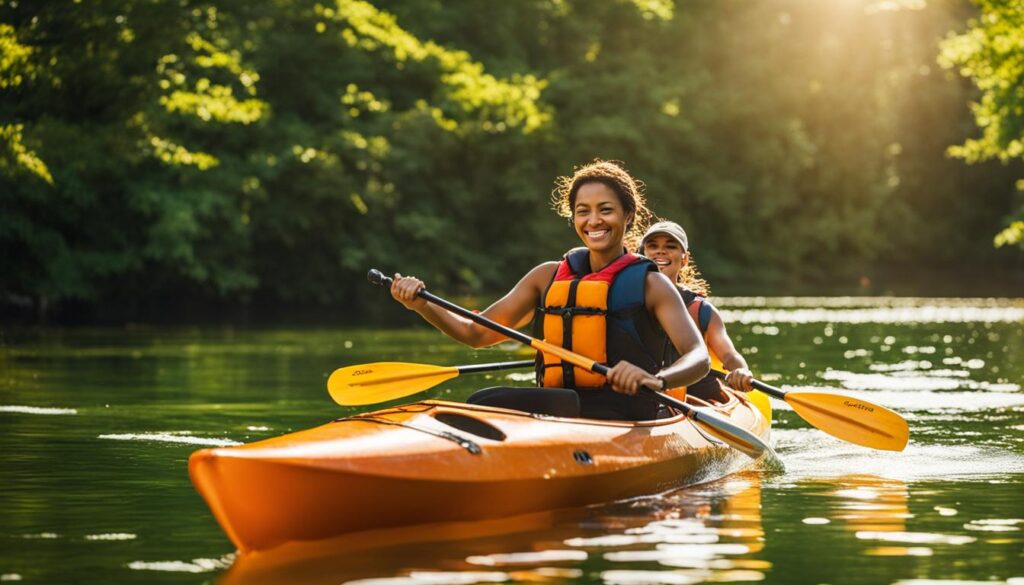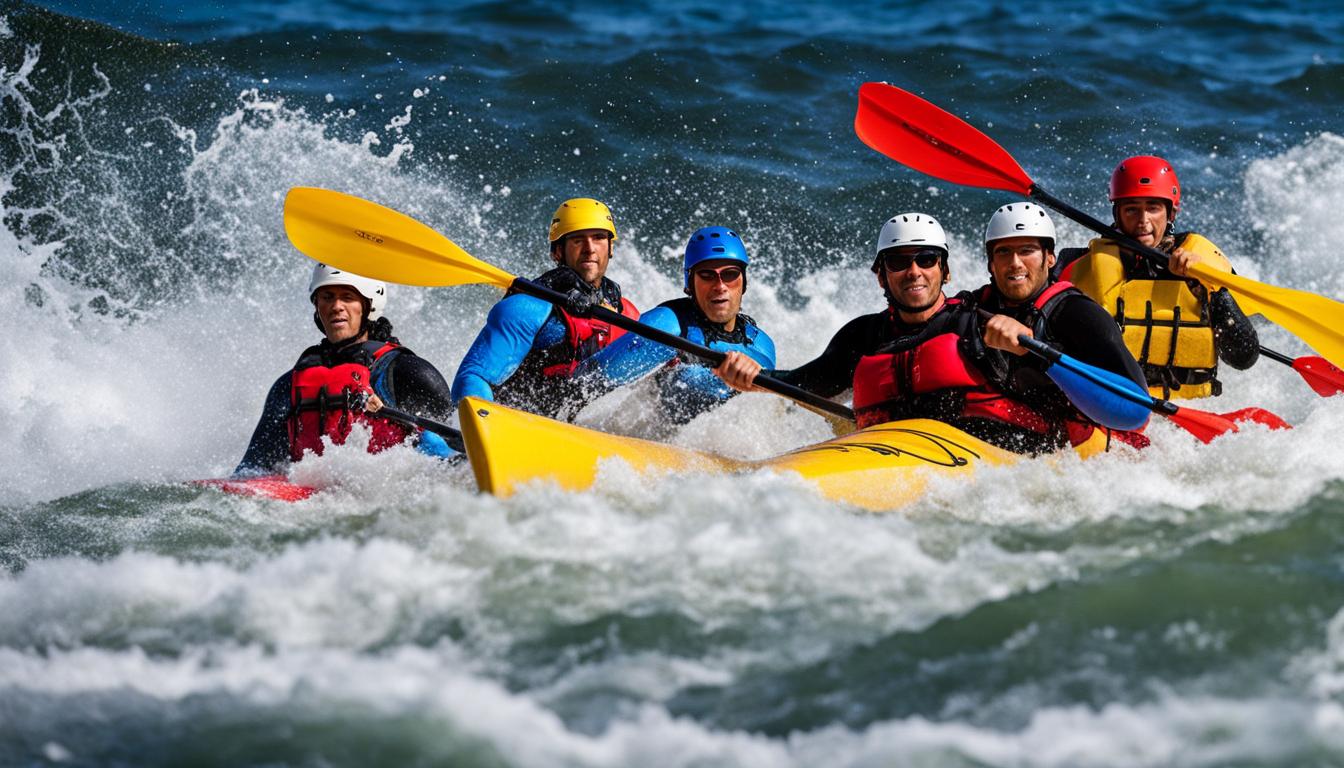Are you considering tandem kayaking but unsure if it’s the right choice for you? In this article, we’ll explore the pros and cons of tandem kayaks, providing you with valuable insights to help you make an informed decision. Whether you’re a seasoned kayaker or a beginner, understanding the dynamics of tandem kayaks is essential.
Key Takeaways:
- Pros and cons of tandem kayaks
- Tandem kayaking insights
- Pros and cons of duo kayaking
What is a Tandem Kayak?
A tandem kayak is a versatile watercraft designed to accommodate two people. With adjustable seats for comfort, tandem kayaks offer a fantastic way to explore the waterways together. They are often longer and wider than single kayaks, providing more stability and higher weight capacities. Tandem kayaks can be made of various materials such as polyethylene, kevlar, or high-strength PVC and Nylon, ensuring durability and resistance to water elements.
The design of a tandem kayak allows for efficient maneuverability on the water. The increased length and width provide better tracking and stability, making it easier for beginners to paddle. By sharing the workload, tandem kayakers can conserve energy during long trips and maintain a steady pace. Additionally, the spacious cockpit allows room for both occupants to stretch their legs and enjoy a comfortable kayaking experience.
Whether you’re an experienced paddler or a novice looking to explore the world of kayaking, tandem kayaks offer significant advantages. Not only do they provide an opportunity for shared adventures and bonding with a partner, but they also allow for improved teamwork and communication. Tandem kayaking is an excellent way to enhance your paddling skills while enjoying the beauty of nature in the company of a friend or loved one.
Understanding Tandem Kayak Dynamics
When paddling a tandem kayak, it’s essential to coordinate your strokes with your partner to ensure smooth and efficient navigation. Communication and teamwork are key to maintaining stability and synchronization. By paddling in unison, you’ll be able to achieve optimal speed and prevent the kayak from veering off course. Practice and patience are necessary to find the perfect rhythm with your partner, but once mastered, tandem kayaking can be a rewarding and enjoyable experience.
| Advantages of Tandem Kayaks | Challenges of Tandem Kayaks |
|---|---|
|
|
Embrace the advantages of tandem kayaks and embark on a memorable journey with a partner. Whether you’re exploring calm lakes, meandering rivers, or tranquil coastal waters, tandem kayaking offers a unique opportunity to create lasting memories and deepen your connection with nature and each other.
Benefits of Tandem Kayaks
Are you looking to enhance your kayaking experience by sharing it with a partner? Tandem kayaks offer a multitude of benefits that make them a great choice for paddling together. From shared kayaking experiences to the advantages of tandem kayaks, let’s dive into why these kayaks are worth considering.
Shared Kayaking Experiences
One of the greatest benefits of tandem kayaks is the opportunity to share your kayaking adventures with a partner. Whether you’re paddling with a friend, a loved one, or even a family member, tandem kayaks allow you to enjoy the experience together. You can explore new waterways, discover hidden coves, and observe nature’s beauty side by side. The shared camaraderie and memories created while paddling in tandem are truly unparalleled.
Balancing in Tandem Kayaks
Tandem kayaks provide a stable and balanced platform, making them ideal for beginners and those new to kayaking. The wider design ensures better stability in the water, allowing you to feel more confident and secure. This stability also makes tandem kayaks easier to paddle, especially for individuals who may be less experienced or have limited strength. With a tandem kayak, you can enjoy your kayaking adventure without worrying about tipping over or feeling unstable.
Advantages of Tandem Kayaks
In addition to shared experiences and stability, tandem kayaks offer other advantages. These kayaks typically have more space and higher weight limits, allowing you to bring along more gear and supplies. Whether you’re planning a day trip or a longer expedition, having the extra storage capacity can be convenient and practical. Furthermore, tandem kayaks are sturdier, which can be reassuring for beginners or those who may be concerned about water conditions. Their durability makes them suitable for various water environments, including lakes, rivers, and even mild coastal areas.
| Advantages | Disadvantages |
|---|---|
| Shared kayaking experiences | Potential for miscommunication between partners |
| Stability and balance | Heavier and more cumbersome to paddle solo |
| More space and higher weight limits | May require coordination to paddle in sync |
| Sturdiness for beginners | Finding a reliable partner can be a challenge |
As with any choice, tandem kayaks do have some drawbacks. Paddling solo in a tandem kayak can be heavier and more cumbersome compared to a single kayak. It may require more effort and technique to maneuver the kayak effectively. Additionally, paddling in sync with a partner can require coordination and communication to maintain a steady rhythm. Finding a reliable partner who shares the same level of enthusiasm and commitment for kayaking may also pose a challenge. However, despite these drawbacks, the benefits and joys of tandem kayaking are worth considering.
If you’re ready to embark on shared kayaking experiences, enjoy the stability and advantages of tandem kayaks, and create lasting memories, a tandem kayak may be the perfect choice for your next adventure.

Table: Pros and Cons of Tandem Kayaks
| Pros | Cons |
|---|---|
| Opportunity to kayak with a partner | Coordination and balance required |
| More space for gear and supplies | Heavier and more cumbersome to paddle solo |
| Higher weight limits | Transportation may be more challenging |
| Sturdier and suitable for beginners | Finding a reliable partner can be a challenge |
How to Choose the Ideal Tandem Kayak
When planning a tandem kayak trip, it’s important to choose the right kayak that meets your needs and preferences. Consider the following factors to ensure you make the ideal choice:
- Type of Kayak: Decide whether you prefer an inflatable or traditional tandem kayak. Inflatable kayaks are portable and easy to store, while traditional kayaks offer more durability and stability.
- Intended Use: Determine the purpose of your tandem kayaking trips. If you plan on taking leisurely recreational trips, a kayak with comfortable seating and storage space for picnic items may be suitable. However, if you’re looking for more intense kayaking sessions, opt for a kayak with advanced features such as rudders or skegs for better control.
- Space and Features: Consider the space requirements for both passengers and equipment. Look for kayaks with ample legroom and storage compartments for gear like dry bags, coolers, and fishing equipment. Some kayaks also offer additional features like cup holders, paddle holders, and adjustable footrests for added convenience.
- Sit-on-Top or Sit-Inside: Decide between a sit-on-top or sit-inside tandem kayak based on your personal preference and comfort. Sit-on-top kayaks are easier to enter and exit, while sit-inside kayaks provide better protection from splashes and wind.
To make an informed decision, it’s crucial to know the weight capacity needed for passengers and gear. Keep in mind that you’ll want to choose a kayak that comfortably accommodates both without sacrificing stability and maneuverability.
By considering these factors and best practices in tandem kayaking, you can select the ideal tandem kayak that will enhance your kayaking experience and provide countless memorable adventures.

Who Benefits Most from a Tandem Kayak
Tandem kayaks offer a range of advantages that make them ideal for various individuals and groups. Whether you’re a couple looking for a shared adventure, a family with children, or a solo paddler seeking more space, a tandem kayak can enhance your kayaking experience.
For couples, tandem kayaks provide the opportunity to bond and create lasting memories. Paddling together allows you to navigate the waters as a team, fostering teamwork and communication. Sharing the experience of exploring new places or simply enjoying the serenity of nature can deepen your connection and create cherished moments.
For social paddlers, tandem kayaks offer a platform to engage in group activities. You can paddle with friends or join guided tandem kayak tours, which provide a fun and interactive way to meet new people who share your love for kayaking.
“Tandem kayaks are not only about double the fun; they also offer a sense of security and stability, making them perfect for families with children,” says experienced kayaker Emily. “Kids can sit in the front seat while parents paddle from the back, ensuring a safe and enjoyable experience for everyone.”
Solo paddlers who desire more space and flexibility also benefit from tandem kayaks. With the extra room, you can comfortably bring along additional gear and supplies for longer excursions. Whether you’re embarking on a solo adventure or simply prefer the freedom that a larger kayak provides, a tandem kayak is an excellent choice.
Comparing the Benefits of Tandem Kayaks
| Advantages | Tandem Kayaks | Single Kayaks |
|---|---|---|
| Shared Experience | ✓ | – |
| More Space | ✓ | – |
| Higher Weight Limit | ✓ | – |
| Stability | ✓ | ✓ |
| Flexibility | ✓ | ✓ |
As shown in the table above, tandem kayaks offer several advantages over single kayaks. The shared experience, extra space, and higher weight limit make tandem kayaks the preferred choice for those looking to enjoy kayaking with a partner, family, or friends.
So, whether you’re seeking adventure, connection, or simply a more versatile kayaking experience, a tandem kayak is sure to provide the advantages you’re looking for.
Conclusion
Tandem kayaks offer unique advantages and challenges for kayakers. Whether you’re looking to kayak with a partner or experience shared adventures, tandem kayaking can provide an exciting and fulfilling experience.
By understanding the dynamics of tandem kayaks, you can make an informed decision about whether it’s the right choice for you. Consider the pros and cons discussed earlier in this article, evaluate your individual needs and preferences, and choose the kayak that best suits your requirements.
Remember, tandem kayaks allow for shared experiences, teamwork, and the opportunity to introduce others, such as children, to the joys of kayaking in a safe environment. So, if you’re seeking a new way to bond with a partner or create lasting memories with friends and family, tandem kayaking may be just the adventure you’re looking for.
So, dive into the world of tandem kayaking, embrace the challenges, and enjoy the incredible experiences that await you on the water!
FAQ
What are the advantages of tandem kayaks?
Tandem kayaks offer the ability to kayak with a partner, more space for gear, and higher weight limits.
Are tandem kayaks heavier than single kayaks?
Yes, tandem kayaks can be heavier and more cumbersome to paddle solo.
Can I paddle a tandem kayak alone?
Yes, you can paddle a tandem kayak alone, but it may require more effort and technique.
Are tandem kayaks suitable for beginners?
Yes, tandem kayaks are sturdier and can be a good choice for beginners.
What materials are tandem kayaks made of?
Tandem kayaks can be made of polyethylene, kevlar, or high-strength PVC and Nylon.
Who benefits most from a tandem kayak?
Tandem kayaks are great for couples, social paddlers, families with children, and solo paddlers who desire more space.
How do I choose the ideal tandem kayak?
Consider factors such as the type of kayak, intended use, required space and features, and weight capacity.





